

Compact Muon Solenoid
LHC, CERN
| CMS-SUS-17-007 ; CERN-EP-2019-093 | ||
| Search for supersymmetry with a compressed mass spectrum in the vector boson fusion topology with 1-lepton and 0-lepton final states in proton-proton collisions at $\sqrt{s} = $ 13 TeV | ||
| CMS Collaboration | ||
| 30 May 2019 | ||
| JHEP 08 (2019) 150 | ||
| Abstract: A search for supersymmetric particles produced in the vector boson fusion topology in proton-proton collisions is presented. The search targets final states with one or zero leptons, large missing transverse momentum, and two jets with a large separation in rapidity. The data sample corresponds to an integrated luminosity of 35.9 fb$^{-1}$ of proton-proton collisions at $\sqrt{s} = $ 13 TeV collected in 2016 with the CMS detector at the LHC. The observed dijet invariant mass and lepton-neutrino transverse mass spectra are found to be consistent with the standard model predictions. Upper limits are set on the cross sections for chargino ($\tilde{\chi}^{\pm}_1$) and neutralino ($\tilde{\chi}^{0}_2$) production with two associated jets. For a compressed mass spectrum scenario in which the $\tilde{\chi}^{\pm}_1$ and $\tilde{\chi}^{0}_2$ decays proceed via a light slepton and the mass difference between the lightest neutralino $\tilde{\chi}^0_1$ and the mass-degenerate particles $\tilde{\chi}^{\pm}_1$ and $\tilde{\chi}^{0}_2$ is 1 (30) GeV, the most stringent lower limit to date of 112 (215) GeV is set on the mass of these latter two particles. | ||
| Links: e-print arXiv:1905.13059 [hep-ex] (PDF) ; CDS record ; inSPIRE record ; HepData record ; CADI line (restricted) ; | ||
| Figures & Tables | Summary | Additional Figures | References | CMS Publications |
|---|
| Figures | |

png pdf |
Figure 1:
Representative Feynman diagrams of (left) chargino-neutralino and (right) chargino-chargino pair production through vector boson fusion, followed by their decays to leptons and the LSP $\tilde{\chi}^0_1$ via a light slepton (top row) or a $\mathrm{W} ^{*}/\mathrm{Z} ^{*}$ (bottom row). Although these representative diagrams show multiple leptons in the final state, the compressed mass spectra scenarios of interest result in low-${p_{\mathrm {T}}}$ leptons, making it unlikely to reconstruct and identify more than one lepton. |

png pdf |
Figure 1-a:
Representative Feynman diagram of chargino-neutralino pair production through vector boson fusion, followed by their decays to leptons and the LSP $\tilde{\chi}^0_1$ via a light slepton. Although this diagram shows multiple leptons in the final state, the compressed mass spectra scenarios of interest result in low-${p_{\mathrm {T}}}$ leptons, making it unlikely to reconstruct and identify more than one lepton. |

png pdf |
Figure 1-b:
Representative Feynman diagram of chargino-chargino pair production through vector boson fusion, followed by their decays to leptons and the LSP $\tilde{\chi}^0_1$ via a light slepton. Although this diagram shows multiple leptons in the final state, the compressed mass spectra scenarios of interest result in low-${p_{\mathrm {T}}}$ leptons, making it unlikely to reconstruct and identify more than one lepton. |

png pdf |
Figure 1-c:
Representative Feynman diagram of chargino-neutralino pair production through vector boson fusion, followed by their decays to leptons and the LSP $\tilde{\chi}^0_1$ via $\mathrm{W} ^{*}/\mathrm{Z} ^{*}$. Although this diagram shows multiple leptons in the final state, the compressed mass spectra scenarios of interest result in low-${p_{\mathrm {T}}}$ leptons, making it unlikely to reconstruct and identify more than one lepton. |
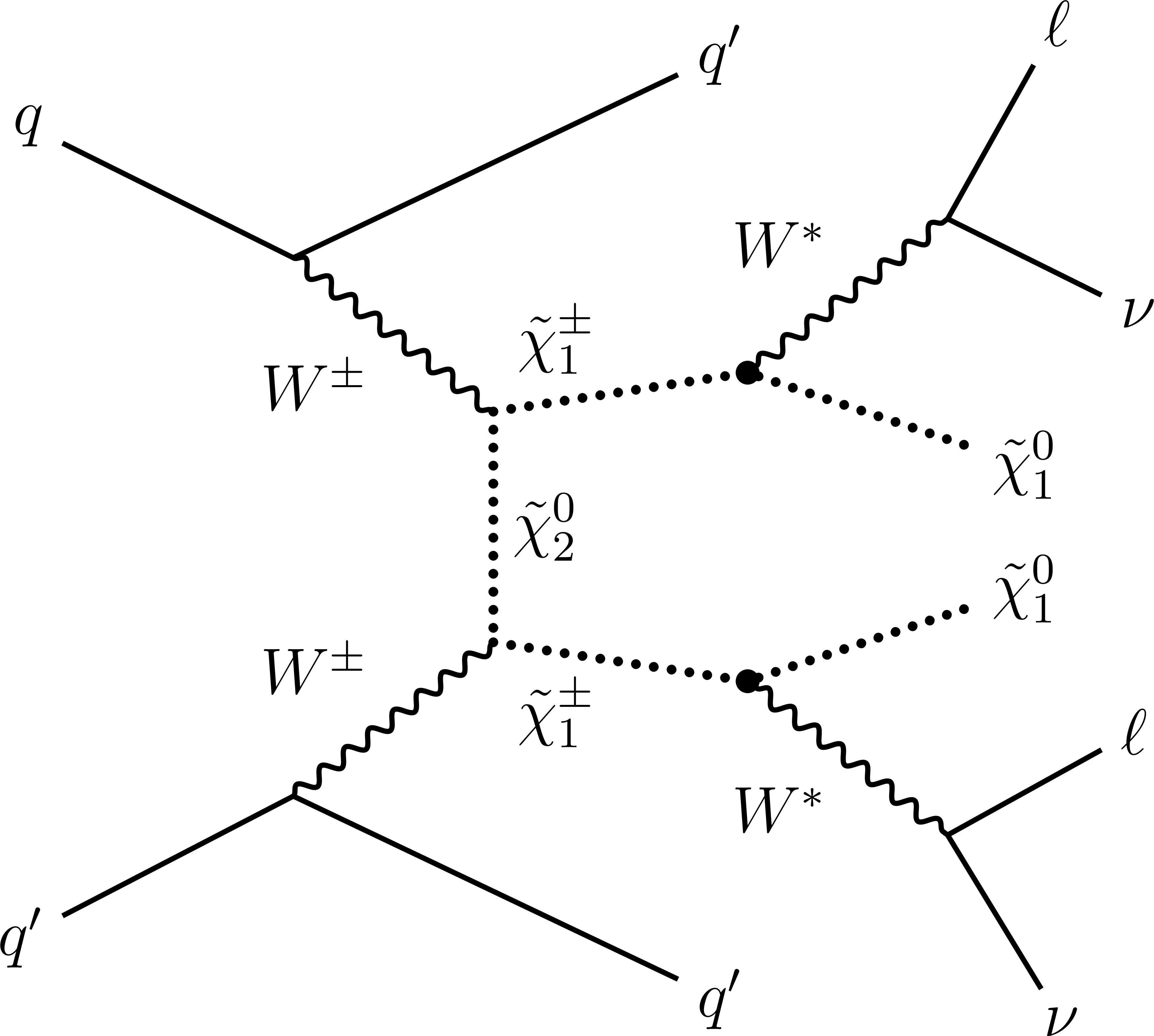
png pdf |
Figure 1-d:
Representative Feynman diagram of chargino-chargino pair production through vector boson fusion, followed by their decays to leptons and the LSP $\tilde{\chi}^0_1$ via $\mathrm{W} ^{*}/\mathrm{Z} ^{*}$. Although this diagram shows multiple leptons in the final state, the compressed mass spectra scenarios of interest result in low-${p_{\mathrm {T}}}$ leptons, making it unlikely to reconstruct and identify more than one lepton. |

png pdf |
Figure 2:
The $ {m_{\mathrm {T}}} $ distributions in the ${\mathrm{t} {}\mathrm{\bar{t}}}$ control regions: (upper left) CR1$_{\mathrm{e}}$, (upper right) CR1$_{\mu}$, and (lower left) CR1$_{{\tau _\mathrm {h}}}$; (lower right) the ${m_\text {jj}}$ distribution for $\mathrm{Z} (\to \nu \nu)$+jets CR2 of the $0\ell \mathrm {jj}$ channel. |
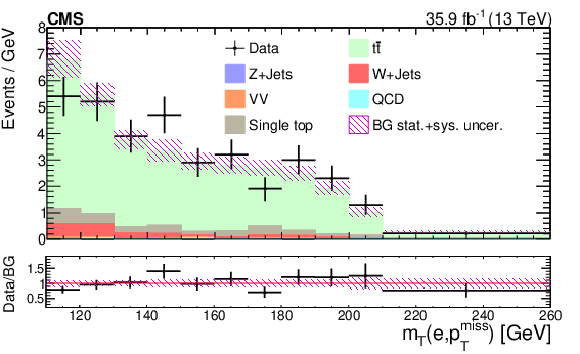
png pdf |
Figure 2-a:
The $ {m_{\mathrm {T}}} $ distribution in the CR1$_{\mathrm{e}}$ ${\mathrm{t} {}\mathrm{\bar{t}}}$ control region. |
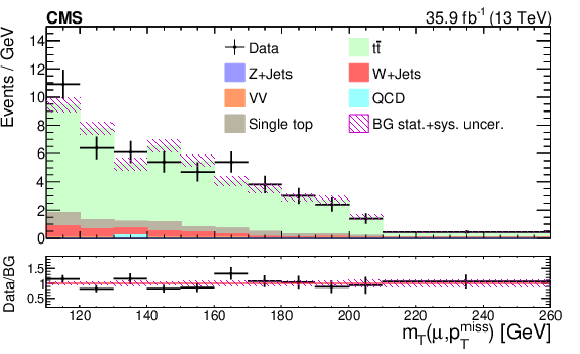
png pdf |
Figure 2-b:
The $ {m_{\mathrm {T}}} $ distribution in the CR1$_{\mu}$ ${\mathrm{t} {}\mathrm{\bar{t}}}$ control region. |

png pdf |
Figure 2-c:
The $ {m_{\mathrm {T}}} $ distribution in the CR1$_{{\tau _\mathrm {h}}}$ ${\mathrm{t} {}\mathrm{\bar{t}}}$ control region. |
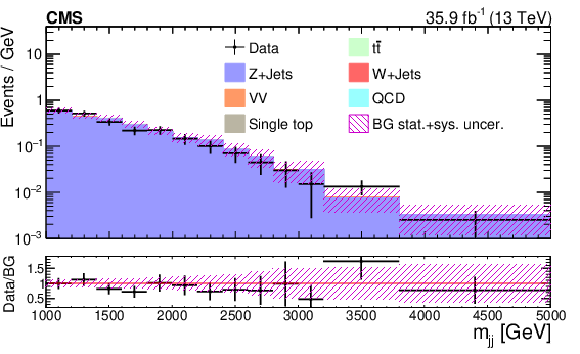
png pdf |
Figure 2-d:
The ${m_\text {jj}}$ distribution for $\mathrm{Z} (\to \nu \nu)$+jets CR2 of the $0\ell \mathrm {jj}$ channel. |

png pdf |
Figure 3:
The observed ${m_{\mathrm {T}}}$ and ${m_\text {jj}}$ distributions in the $\mathrm{e} \mathrm {jj}$ (upper left), $\mu \mathrm {jj}$ (upper right), $ {\tau _\mathrm {h}} \mathrm {jj}$ (lower left), and $0\ell \mathrm {jj}$ (lower right) signal regions compared with the post-fit SM background yields from the fit described in the text. The pre-fit background yields and shapes are determined using data-driven methods for the major backgrounds, and based on simulation for the smaller backgrounds. Expected signal distributions are overlaid. The last bin in the ${m_{\mathrm {T}}}$ distributions of the $1\ell \mathrm {jj}$ channels include all events with $ {m_{\mathrm {T}}} > $ 210 GeV. The last bin of the ${m_\text {jj}}$ distributions of the $0\ell \mathrm {jj}$ channel include all events with $ {m_\text {jj}} > $ 3800 GeV. |

png pdf |
Figure 3-a:
The observed ${m_{\mathrm {T}}}$ distribution in the $\mathrm{e} \mathrm {jj}$ signal region compared with the post-fit SM background yields from the fit described in the text. The pre-fit background yields and shapes are determined using data-driven methods for the major backgrounds, and based on simulation for the smaller backgrounds. Expected signal distributions are overlaid. The last bin of the distribution includes all events with $ {m_{\mathrm {T}}} > $ 210 GeV. |

png pdf |
Figure 3-b:
The observed ${m_{\mathrm {T}}}$ distribution in the $\mu \mathrm {jj}$ signal region compared with the post-fit SM background yields from the fit described in the text. The pre-fit background yields and shapes are determined using data-driven methods for the major backgrounds, and based on simulation for the smaller backgrounds. Expected signal distributions are overlaid. The last bin of the distribution includes all events with $ {m_{\mathrm {T}}} > $ 210 GeV. |

png pdf |
Figure 3-c:
The observed ${m_{\mathrm {T}}}$ distribution in the $ {\tau _\mathrm {h}} \mathrm {jj}$ signal region compared with the post-fit SM background yields from the fit described in the text. The pre-fit background yields and shapes are determined using data-driven methods for the major backgrounds, and based on simulation for the smaller backgrounds. Expected signal distributions are overlaid. The last bin of the distribution includes all events with $ {m_{\mathrm {T}}} > $ 210 GeV. |
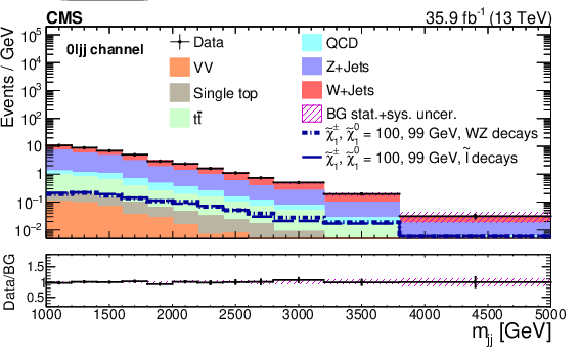
png pdf |
Figure 3-d:
The observed ${m_\text {jj}}$ distribution in the $0\ell \mathrm {jj}$ signal region compared with the post-fit SM background yields from the fit described in the text. The pre-fit background yields and shapes are determined using data-driven methods for the major backgrounds, and based on simulation for the smaller backgrounds. Expected signal distributions are overlaid. The last bin of the distribution includes all events with $ {m_\text {jj}} > $ 3800 GeV. |

png pdf |
Figure 4:
Combined 95% CL UL on the cross section as a function of $m_{\tilde{\chi}^{0}_2}=m_{\tilde{\chi}^{\pm}_1}$. The results correspond to $\Delta m = $ 1 GeV (left) and $\Delta m = $ 50 GeV (right) mass gaps between the chargino and the lightest neutralino. The top row shows the expected limits, and the bottom row shows the observed limits. |
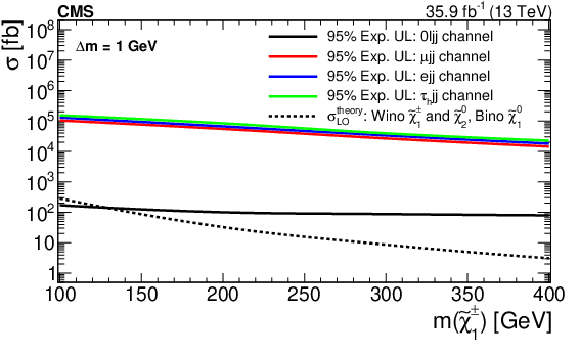
png pdf |
Figure 4-a:
Combined 95% CL expected UL on the cross section as a function of $m_{\tilde{\chi}^{0}_2}=m_{\tilde{\chi}^{\pm}_1}$. The results correspond to $\Delta m = $ 1 GeV mass gaps between the chargino and the lightest neutralino. |
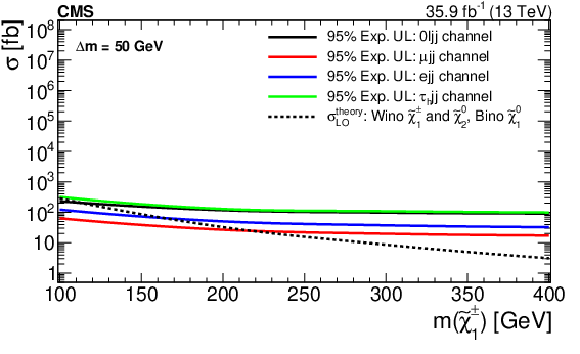
png pdf |
Figure 4-b:
Combined 95% CL expected UL on the cross section as a function of $m_{\tilde{\chi}^{0}_2}=m_{\tilde{\chi}^{\pm}_1}$. The results correspond to $\Delta m = $ 50 GeV mass gaps between the chargino and the lightest neutralino. |

png pdf |
Figure 4-c:
Combined 95% CL observed UL on the cross section as a function of $m_{\tilde{\chi}^{0}_2}=m_{\tilde{\chi}^{\pm}_1}$. The results correspond to $\Delta m = $ 1 GeV mass gaps between the chargino and the lightest neutralino. |
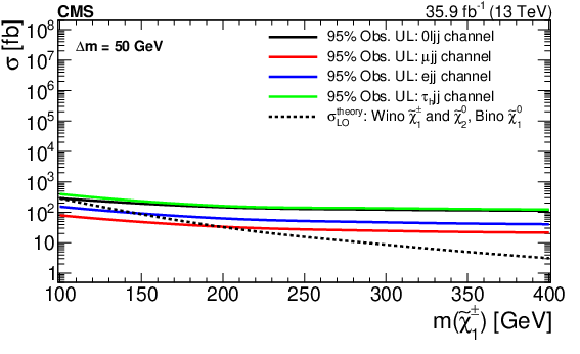
png pdf |
Figure 4-d:
Combined 95% CL observed UL on the cross section as a function of $m_{\tilde{\chi}^{0}_2}=m_{\tilde{\chi}^{\pm}_1}$. The results correspond to $\Delta m = $ 50 GeV mass gaps between the chargino and the lightest neutralino. |

png pdf |
Figure 5:
(Left) Expected and observed 95% confidence level upper limit (UL) on the signal cross section as a function of $m(\tilde{\chi}^{\pm}_1)$ and $\Delta m$, assuming the light slepton model with slepton mass defined as the average of the $\tilde{\chi}^{0}_2$ and $\tilde{\chi}^{\pm}_1$ masses, $x_{\tilde{\ell}}=$ 0.5. (Right) Combined 95% CL UL on the cross section as a function of $m_{\tilde{\chi}^{0}_2}=m_{\tilde{\chi}^{\pm}_1}$, for $\Delta m = $ 1 GeV and $\Delta m = $ 30 GeV mass gaps between the chargino and the neutralino, assuming the light slepton model. |

png pdf |
Figure 5-a:
Expected and observed 95% confidence level upper limit (UL) on the signal cross section as a function of $m(\tilde{\chi}^{\pm}_1)$ and $\Delta m$, assuming the light slepton model with slepton mass defined as the average of the $\tilde{\chi}^{0}_2$ and $\tilde{\chi}^{\pm}_1$ masses, $x_{\tilde{\ell}}=$ 0.5. |
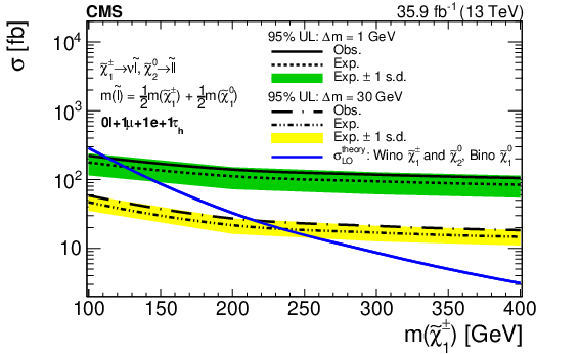
png pdf |
Figure 5-b:
Combined 95% CL UL on the cross section as a function of $m_{\tilde{\chi}^{0}_2}=m_{\tilde{\chi}^{\pm}_1}$, for $\Delta m = $ 1 GeV and $\Delta m = $ 30 GeV mass gaps between the chargino and the neutralino, assuming the light slepton model. |

png pdf |
Figure 6:
(Left) Expected and observed 95% confidence level upper limit (UL) on the signal cross section as a function of $m(\tilde{\chi}^{\pm}_1)$ and $\Delta m$, assuming the $\tilde{\chi}^{\pm}_1$ and $\tilde{\chi}^{0}_2$ decays proceed via $\mathrm{W} ^{*}$ and $\mathrm{Z} ^{*}$. (Right) The 95% CL UL on the cross section as a function of $m_{\tilde{\chi}^{0}_2}=m_{\tilde{\chi}^{\pm}_1}$, for $\Delta m = $ 1 GeV and $\Delta m = $ 30 GeV mass gaps between the chargino and the neutralino, after combining 0 lepton and 1 lepton channels, assuming the $\tilde{\chi}^{\pm}_1$ and $\tilde{\chi}^{0}_2$ decays proceed via $\mathrm{W} ^{*}$ and $\mathrm{Z} ^{*}$. |

png pdf |
Figure 6-a:
Expected and observed 95% confidence level upper limit (UL) on the signal cross section as a function of $m(\tilde{\chi}^{\pm}_1)$ and $\Delta m$, assuming the $\tilde{\chi}^{\pm}_1$ and $\tilde{\chi}^{0}_2$ decays proceed via $\mathrm{W} ^{*}$ and $\mathrm{Z} ^{*}$. |

png pdf |
Figure 6-b:
The 95% CL UL on the cross section as a function of $m_{\tilde{\chi}^{0}_2}=m_{\tilde{\chi}^{\pm}_1}$, for $\Delta m = $ 1 GeV and $\Delta m = $ 30 GeV mass gaps between the chargino and the neutralino, after combining 0 lepton and 1 lepton channels, assuming the $\tilde{\chi}^{\pm}_1$ and $\tilde{\chi}^{0}_2$ decays proceed via $\mathrm{W} ^{*}$ and $\mathrm{Z} ^{*}$. |
| Tables | |

png pdf |
Table 1:
The number of observed events and corresponding background predictions. The uncertainties include the statistical and systematic components. |
| Summary |
| A search is presented for noncolored supersymmetric particles produced in the vector boson fusion (VBF) topology using data corresponding to an integrated luminosity of 35.9 fb$^{-1}$ collected in 2016 with the CMS detector in proton-proton collisions at $\sqrt{s} = $ 13 TeV. The search utilizes events in four different channels depending on the number and type of leptons: $0\ell \mathrm{jj}$, $\mathrm{e} \mathrm{jj}$, $\mu \mathrm{jj}$, and ${\tau_\mathrm{h}} \mathrm{jj}$, where ${\tau_\mathrm{h}}$ denotes a hadronically decaying ${\tau}$ lepton. While Ref. [60] reported a search using the VBF dijet topology with a zero-lepton final state in proton-proton collision data at $\sqrt{s} = $ 8 TeV, this is the first search for the compressed electroweak supersymmetry (SUSY) sector using the $0\ell \mathrm{jj}$ final state. This is also the first search for SUSY in the VBF topology with single soft-lepton final states. The VBF topology requires two well-separated jets that appear in opposite hemispheres, with large invariant mass ${m_\text{jj}} $. The observed ${m_\text{jj}}$ and transverse mass $m_{\mathrm{T}}(\ell,p_{\mathrm{T}}^{\text{miss}})$ distributions do not reveal any evidence for new physics. The results are used to exclude a range of $\tilde{\chi}^{\pm}_1$ and $\tilde{\chi}^{0}_2$ gaugino masses. For a compressed mass spectrum scenario, in which $\Delta m \equiv m(\tilde{\chi}^{\pm}_1) -m(\tilde{\chi}^0_1) = $ 1 (30) GeV and in which $\tilde{\chi}^{\pm}_1$ and $\tilde{\chi}^{0}_2$ branching fractions to light sleptons are 100%, $\tilde{\chi}^{\pm}_1$ and $\tilde{\chi}^{0}_2$ masses up to 112 (215) GeV are excluded at 95% CL . For the scenario where the sleptons are too heavy and decays of the charginos and neutralinos proceed via $\mathrm{W}^{*}$ and $\mathrm{Z}^{*}$ bosons, $\tilde{\chi}^{\pm}_1$ and $\tilde{\chi}^{0}_2$ masses up to 112 (175) GeV are excluded at 95% CL for $\Delta m = $ 1 (30) GeV. While many previous studies at the LHC have focused on strongly coupled supersymmetric particles, including searches for charginos and neutralinos produced in gluino or squark decay chains, and a number of studies have presented limits on the Drell-Yan production of charginos and neutralinos, this analysis obtains the most stringent limits to date on the production of charginos and neutralinos decaying to leptons in compressed mass spectrum scenarios defined by the mass separation 1 $ \le \Delta m < $ 3 GeV and 25 $ \le \Delta m < $ 50 GeV. |
| Additional Figures | |
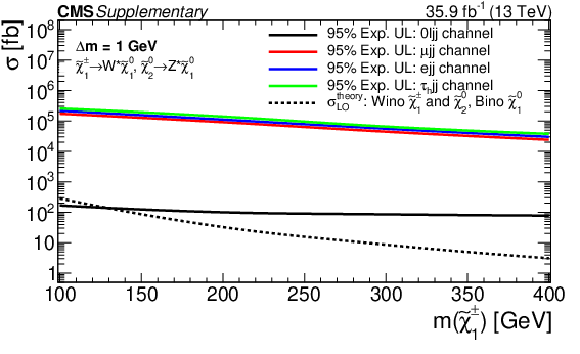
png pdf |
Additional Figure 1:
Combined 95% CL expected upper limit on the signal cross section as a function of $m_{\tilde{\chi}^{0}_{2}}=m_{\tilde{\chi}^\pm _{1}}$ for a $\Delta m = $ 1 GeV mass gap between the chargino and the lightest neutralino in the WZ model. |

png pdf |
Additional Figure 2:
Combined 95% CL expected upper limit on the signal cross section as a function of $m_{\tilde{\chi}^{0}_{2}}=m_{\tilde{\chi}^\pm _{1}}$ for a $\Delta m = $ 50 GeV mass gap between the chargino and the lightest neutralino in the WZ model. |
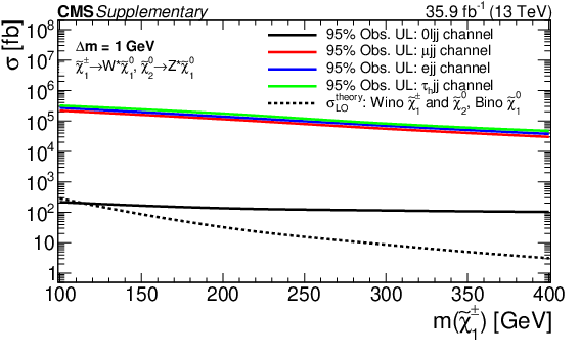
png pdf |
Additional Figure 3:
Combined 95% CL observed upper limit on the signal cross section as a function of $m_{\tilde{\chi}^{0}_{2}}=m_{\tilde{\chi}^\pm _{1}}$ for a $\Delta m = $ 1 GeV mass gap between the chargino and the lightest neutralino in the WZ model. |

png pdf |
Additional Figure 4:
Combined 95% CL observed upper limit on the signal cross section as a function of $m_{\tilde{\chi}^{0}_{2}}=m_{\tilde{\chi}^\pm _{1}}$ for a $\Delta m = $ 50 GeV mass gap between the chargino and the lightest neutralino in the WZ model. |
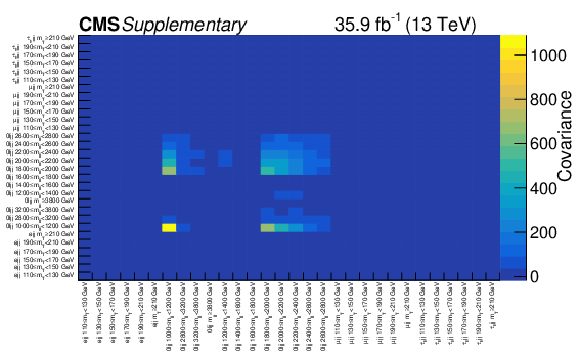
png pdf |
Additional Figure 5:
Covariance matrix from the combined fit of the $m_{\textrm {jj}}$ and $m_{\textrm {T}}$ distributions in the 0$\ell \textrm {jj}$ and 1$\ell \textrm {jj}$ search regions. |
| References | ||||
| 1 | P. Ramond | Dual theory for free fermions | PRD 3 (1971) 2415 | |
| 2 | Y. A. Gol'fand and E. P. Likhtman | Extension of the algebra of Poincare group generators and violation of P invariance | JEPTL 13 (1971) 323 | |
| 3 | S. Ferrara and B. Zumino | Supergauge invariant Yang-Mills theories | NPB 79 (1974) 413 | |
| 4 | J. Wess and B. Zumino | Supergauge transformations in four dimensions | NPB 70 (1974) 39 | |
| 5 | A. H. Chamseddine, R. Arnowitt, and P. Nath | Locally supersymmetric grand unification | PRL 49 (1982) 970 | |
| 6 | R. Barbieri, S. Ferrara, and C. A. Savoy | Gauge models with spontaneously broken local supersymmetry | PLB 119 (1982) 343 | |
| 7 | L. Hall, J. Lykken, and S. Weinberg | Supergravity as the messenger of supersymmetry breaking | PRD 27 (1983) 2359 | |
| 8 | CMS Collaboration | Search for new phenomena with the $ M_{\mathrm {T2}} $ variable in the all-hadronic final state produced in proton-proton collisions at $ \sqrt{s} = $ 13 TeV | EPJC 77 (2017) 710 | CMS-SUS-16-036 1705.04650 |
| 9 | CMS Collaboration | Search for supersymmetry in multijet events with missing transverse momentum in proton-proton collisions at 13 TeV | PRD 96 (2017) 032003 | CMS-SUS-16-033 1704.07781 |
| 10 | J. Alwall, P. Schuster, and N. Toro | Simplified models for a first characterization of new physics at the LHC | PRD 79 (2009) 075020 | 0810.3921 |
| 11 | LHC New Physics Working Group Collaboration | Simplified models for LHC new physics searches | JPG 39 (2012) 105005 | 1105.2838 |
| 12 | G. R. Farrar and P. Fayet | Phenomenology of the production, decay, and detection of new hadronic states associated with supersymmetry | PLB 76 (1978) 575 | |
| 13 | CMS Collaboration | Combined search for electroweak production of charginos and neutralinos in proton-proton collisions at $ \sqrt{s} = $ 13 TeV | JHEP 03 (2018) 160 | CMS-SUS-17-004 1801.03957 |
| 14 | ATLAS Collaboration | Search for the direct production of charginos and neutralinos in final states with tau leptons in $ \sqrt{s} = $ 13 TeV pp collisions with the ATLAS detector | EPJC 78 (2018) 154 | 1708.07875 |
| 15 | ATLAS Collaboration | Search for electroweak production of supersymmetric states in scenarios with compressed mass spectra at $ \sqrt{s} = $ 13 TeV with the ATLAS detector | PRD 97 (2018) 052010 | 1712.08119 |
| 16 | CMS Collaboration | Search for new physics in events with two soft oppositely charged leptons and missing transverse momentum in proton-proton collisions at $ \sqrt{s} = $ 13 TeV | PLB 782 (2018) 440 | CMS-SUS-16-048 1801.01846 |
| 17 | B. Dutta et al. | Vector boson fusion processes as a probe of supersymmetric electroweak sectors at the LHC | PRD 87 (2013) 035029 | 1210.0964 |
| 18 | A. G. Delannoy et al. | Probing dark matter at the LHC using vector boson fusion processes | PRL 111 (2013) 061801 | 1304.7779 |
| 19 | CMS Collaboration | Search for supersymmetry in the vector-boson fusion topology in proton-proton collisions at $ \sqrt{s}= $ 8 TeV | JHEP 11 (2015) 189 | CMS-SUS-14-005 1508.07628 |
| 20 | CMS Collaboration | The CMS experiment at the CERN LHC | JINST 3 (2008) S08004 | CMS-00-001 |
| 21 | CMS Collaboration | Particle-flow reconstruction and global event description with the CMS detector | JINST 12 (2017) P10003 | CMS-PRF-14-001 1706.04965 |
| 22 | CMS Collaboration | Performance of missing energy reconstruction in 13 TeV pp collision data using the CMS detector | CMS-PAS-JME-16-004 | CMS-PAS-JME-16-004 |
| 23 | M. Cacciari, G. P. Salam, and G. Soyez | The anti-$ {k_{\mathrm{T}}} $ jet clustering algorithm | JHEP 04 (2008) 063 | 0802.1189 |
| 24 | CMS Collaboration | FastJet user manual | EPJC 72 (2012) 1896 | 1111.6097 |
| 25 | M. Cacciari and G. P. Salam | Pileup subtraction using jet areas | PLB 659 (2008) 119 | 0707.1378 |
| 26 | CMS Collaboration | Jet energy scale and resolution in the CMS experiment in pp collisions at 8 TeV | JINST 12 (2017) P02014 | CMS-JME-13-004 1607.03663 |
| 27 | CMS Collaboration | Pileup jet identification | CMS-PAS-JME-13-005 | CMS-PAS-JME-13-005 |
| 28 | CMS Collaboration | Identification of heavy-flavour jets with the CMS detector in pp collisions at 13 TeV | JINST 13 (2018) P05011 | CMS-BTV-16-002 1712.07158 |
| 29 | CMS Collaboration | Performance of the CMS muon detector and muon reconstruction with proton-proton collisions at $ \sqrt{s}= $ 13 TeV | JINST 13 (2018) P06015 | CMS-MUO-16-001 1804.04528 |
| 30 | CMS Collaboration | Performance of electron reconstruction and selection with the CMS detector in proton-proton collisions at $ \sqrt{s} = $ 8 TeV | JINST 10 (2015) P06005 | CMS-EGM-13-001 1502.02701 |
| 31 | CMS Collaboration | Reconstruction and identification of $ \tau $ lepton decays to hadrons and $ \nu_{\tau} $ at CMS | JINST 11 (2016) P01019 | CMS-TAU-14-001 1510.07488 |
| 32 | J. Alwall et al. | The automated computation of tree-level and next-to-leading order differential cross sections, and their matching to parton shower simulations | JHEP 07 (2014) 079 | 1405.0301 |
| 33 | R. Frederix, E. Re, and P. Torrielli | Single-top $ t $-channel hadroproduction in the four-flavour scheme with POWHEG and aMC@NLO | JHEP 09 (2012) 130 | 1207.5391 |
| 34 | P. Nason | A new method for combining NLO QCD with shower Monte Carlo algorithms | JHEP 11 (2004) 040 | hep-ph/0409146 |
| 35 | S. Frixione, P. Nason, and C. Oleari | Matching NLO QCD computations with parton shower simulations: the POWHEG method | JHEP 11 (2007) 070 | 0709.2092 |
| 36 | S. Alioli, P. Nason, C. Oleari, and E. Re | A general framework for implementing NLO calculations in shower Monte Carlo programs: the POWHEG BOX | JHEP 06 (2010) 043 | 1002.2581 |
| 37 | E. Re | Single-top $ \textrm{Wt} $-channel production matched with parton showers using the POWHEG method | EPJC 71 (2011) 1547 | 1009.2450 |
| 38 | T. Sjostrand et al. | An introduction to PYTHIA 8.2 | CPC 191 (2015) 159 | 1410.3012 |
| 39 | CMS Collaboration | Event generator tunes obtained from underlying event and multiparton scattering measurements | EPJC 76 (2016) 155 | CMS-GEN-14-001 1512.00815 |
| 40 | NNPDF Collaboration | Parton distributions for the LHC Run II | JHEP 04 (2015) 040 | 1410.8849 |
| 41 | J. Alwall et al. | Comparative study of various algorithms for the merging of parton showers and matrix elements in hadronic collisions | EPJC 53 (2008) 473 | 0706.2569 |
| 42 | S. Alioli, P. Nason, C. Oleari, and E. Re | NLO single-top production matched with shower in POWHEG: $ s $- and $ t $-channel contributions | JHEP 09 (2009) 111 | 0907.4076 |
| 43 | M. Czakon and A. Mitov | Top++: a program for the calculation of the top-pair cross-section at hadron colliders | CPC 185 (2014) 2930 | 1112.5675 |
| 44 | \GEANTfour Collaboration | GEANT4 -- a simulation toolkit | NIMA 506 (2003) 250 | |
| 45 | S. Abdullin et al. | The fast simulation of the CMS detector at LHC | J. Phys. Conf. Ser. 331 (2011) 032049 | |
| 46 | B. Dutta et al. | Probing compressed bottom squarks with boosted jets and shape analysis | PRD 92 (2015) 095009 | 1507.01001 |
| 47 | B. Dutta et al. | Probing compressed top squarks at the LHC at 14 TeV | PRD 90 (2014) 095022 | 1312.1348 |
| 48 | B. Dutta et al. | Probing compressed sleptons at the LHC using vector boson fusion processes | PRD 91 (2015) 055025 | 1411.6043 |
| 49 | A. Fl\'orez et al. | Searching for new heavy neutral gauge bosons using vector boson fusion processes at the LHC | PLB 767 (2017) 126 | 1609.09765 |
| 50 | A. Fl\'orez et al. | Expanding the reach of heavy neutrino searches at the LHC | PLB 778 (2018) 94 | 1708.03007 |
| 51 | A. Fl\'orez et al. | Probing heavy spin-2 bosons with $ \gamma\gamma $ final states from vector boson fusion processes at the LHC | PRD 99 (2019) 035034 | 1812.06824 |
| 52 | CMS Collaboration | CMS luminosity measurements for the 2016 data-taking period | CMS-PAS-LUM-17-001 | CMS-PAS-LUM-17-001 |
| 53 | J. Butterworth et al. | PDF4LHC recommendations for LHC run II | JPG 43 (2016) 023001 | 1510.03865 |
| 54 | P. M. Nadolsky et al. | Implications of CTEQ global analysis for collider observables | PRD 78 (2008) 013004 | 0802.0007 |
| 55 | A. D. Martin, W. J. Stirling, R. S. Thorne, and G. Watt | Update of parton distributions at NNLO | PLB 652 (2007) 292 | 0706.0459 |
| 56 | M. Ubiali | NNPDF1.0 parton set for the LHC | NPPS 186 (2009) 62 | 0809.3716 |
| 57 | G. Cowan, K. Cranmer, E. Gross, and O. Vitells | Asymptotic formulae for likelihood-based tests of new physics | EPJC 71 (2011) 1554 | 1007.1727 |
| 58 | T. Junk | Confidence level computation for combining searches with small statistics | NIMA 434 (1999) 435 | |
| 59 | A. L. Read | Presentation of search results: the $ CL_{s} $ technique | JPG 28 (2002) 2693 | |
| 60 | CMS Collaboration | Search for dark matter and supersymmetry with a compressed mass spectrum in the vector boson fusion topology in proton-proton collisions at $ \sqrt{s} = $ 8 TeV | PRL \bf 118 (2017) 021802 | CMS-SUS-14-019 1605.09305 |

|
Compact Muon Solenoid LHC, CERN |

|

|

|

|

|

|